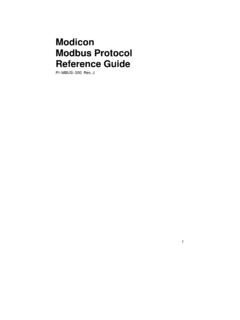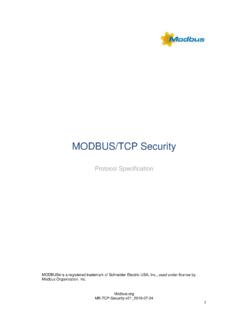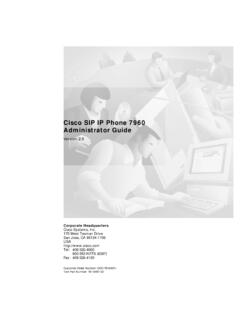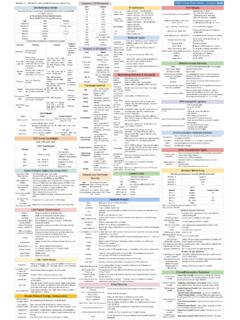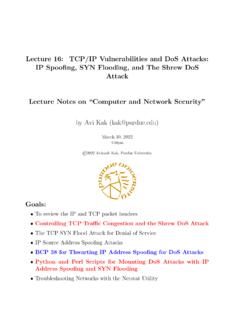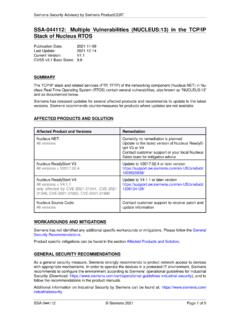Transcription of MODBUS MESSAGING ON TCP/IP IMPLEMENTATION GUIDE V1
1 MODBUS MESSAGING on TCP/IP IMPLEMENTATION GUIDE MODBUS Organization October 24, 2006 MESSAGING ON TCP/IP IMPLEMENTATION GUIDE CONTENTS 1 INTRODUCTION .. 2 OBJECTIVES .. 2 CLIENT / SERVER 2 REFERENCE DOCUMENTS .. 3 2 ABBREVIATIONS .. 3 3 CONTEXT .. 3 PROTOCOL DESCRIPTION .. 3 General communication architecture .. 3 MODBUS On TCP/IP Application Data Unit .. 4 MBAP Header description .. 5 MODBUS FUNCTIONS CODES DESCRIPTION .. 6 4 FUNCTIONAL 7 MODBUS COMPONENT ARCHITECTURE 7 TCP CONNECTION MANAGEMENT ..10 Connections management Impact of Operating Modes on the TCP Access Control Module ..14 USE of TCP/IP STACK ..14 Use of BSD Socket interface ..15 TCP layer IP layer parameterization ..19 COMMUNICATION APPLICATION LAYER ..20 MODBUS Client ..20 MODBUS Server ..26 5 IMPLEMENTATION GUIDELINE ..32 OBJECT MODEL DIAGRAM ..32 TCP management package ..33 Configuration layer Communication layer Interface IMPLEMENTATION CLASS SEQUENCE CLASSES AND METHODS DESCRIPTION.
2 42 MODBUS Server Class ..42 MODBUS Client Interface Classes ..44 Connexion Management MODBUS MESSAGING on TCP/IP IMPLEMENTATION GUIDE 1 INTRODUCTION OBJECTIVES The objective of this document is to present the MODBUS MESSAGING service over TCP/IP , in order to provide reference information that helps software developers to implement this service. The encoding of the MODBUS function codes is not described in this document, for this information please read the MODBUS Application Protocol Specification [1]. This document gives accurate and comprehensive description of a MODBUS MESSAGING service IMPLEMENTATION . Its purpose is to facilitate the interoperability between the devices using the MODBUS MESSAGING service. This document comprises mainly three parts: An overview of the MODBUS over TCP/IP protocol A functional description of a MODBUS client, server and gatewayimplementation.
3 An IMPLEMENTATION guideline that proposes the object model of an MODBUS IMPLEMENTATION CLIENT / SERVER MODEL The MODBUS MESSAGING service provides a Client/Server communication between devices connected on an Ethernet TCP/IP network. This client / server model is based on four type of messages: MODBUS Request, MODBUS Confirmation, MODBUS Indication, MODBUS ResponseMODBUS ClientMODBUS ServerRequestIndicationResponseConfirmat ionA MODBUS Request is the message sent on the network by the Client to initiate a transaction, A MODBUS Indication is the Request message received on the Server side, A MODBUS Response is the Response message sent by the Server, A MODBUS Confirmation is the Response Message received on the Client side The MODBUS MESSAGING services (Client / Server Model) are used for real time information exchange: between two device applications, between device application and other device, between HMI/SCADA applications and devices, between a PC and a device program providing on line 24, 2006 Organization MODBUS MESSAGING on TCP/IP IMPLEMENTATION GUIDE October 24, 2006 REFERENCE DOCUMENTS This section gives a list of documents that are interesting to read before this one.
4 [1] MODBUS Application Protocol Specification [2]RFC 1122 Requirements for Internet Hosts -- Communication Layers2 ABBREVIATIONS ADU Application Data Unit IETF Internet Engineering Task Force IP Internet Protocol MAC Medium Access Control MB MODBUS MBAP MODBUS Application Protocol PDU Protocol Data Unit PLC Programmable Logic Controller TCP Transport Control Protocol BSD Berkeley Software Distribution MSL Maximum Segment Lifetime 3 CONTEXT PROTOCOL DESCRIPTION General communication architecture A communicating system over MODBUS TCP/IP may include different types of device: A MODBUS TCP/IP Client and Server devices connected to a TCP/IP network The Interconnection devices like bridge, router or gateway for interconnectionbetween the TCP/IP network and a serial line sub-network which permitconnections of MODBUS Serial line Client and Server end Organization MODBUS MESSAGING on TCP/IP IMPLEMENTATION GUIDE MODBUS Client TCP/IP MODBUS Server TCP/IP MODBUS Server TCP/IP MODBUS Server Serial Line MODBUS Server Serial Line MODBUS Client Serial Line MODBUS Client TCP/IP MODBUS Client TCP/IPServer TCP/IPgatewayMODBUS Serial Figure 1: MODBUS TCP/IP communication architecture The MODBUS protocol defines a simple Protocol Data Unit (PDU) independent of the underlying communication layers.
5 The mapping of MODBUS protocol on specific buses or networks can introduce some additional fields on the Application Data Unit (ADU). Additional addressFunction codeDataError checkADUPDUF igure 2: General MODBUS frame The client that initiates a MODBUS transaction builds the MODBUS Application Data Unit. The function code indicates to the server which kind of action to perform. MODBUS On TCP/IP Application Data Unit This section describes the encapsulation of a MODBUS request or response when it is carried on a MODBUS TCP/IP network. Function codeDataMBAP HeaderPDUMODBUS TCP/IP ADUF igure 3: MODBUS request/response over TCP/IP A dedicated header is used on TCP/IP to identify the MODBUS Application Data Unit. It is called the MBAP header ( MODBUS Application Protocol header). October 24, 2006 Organization MODBUS MESSAGING on TCP/IP IMPLEMENTATION GUIDE October 24, 2006 header provides some differences compared to the MODBUS RTU application data unit used on serial line: The MODBUS slave address field usually used on MODBUS Serial Line isreplaced by a single byte Unit Identifier within the MBAP Header.
6 The Unit Identifier is used to communicate via devices such as bridges,routers and gateways that use a single IP address to support multipleindependent MODBUS end units. All MODBUS requests and responses are designed in such a way that therecipient can verify that a message is finished. For function codes wherethe MODBUS PDU has a fixed length, the function code alone is function codes carrying a variable amount of data in the request orresponse, the data field includes a byte count. When MODBUS is carried over TCP, additional length information iscarried in the MBAP header to allow the recipient to recognize messageboundaries even if the message has been split into multiple packets fortransmission. The existence of explicit and implicit length rules, and use ofa CRC-32 error check code (on Ethernet) results in an infinitesimal chanceof undetected corruption to a request or response MBAP Header description The MBAP Header contains the following fields: Fields Length Description - Client Server Transaction Identifier 2 Bytes Identification of a MODBUS Request / Response transaction.
7 Initialized by the client Recopied by the server from the received request Protocol Identifier 2 Bytes 0 = MODBUS protocol Initialized by the client Recopied by the server from the received request Length 2 Bytes Number of following bytes Initialized by the client ( request) Initialized by the server ( Response) Unit Identifier 1 Byte Identification of a remote slave connected on a serial line or on other buses. Initialized by the client Recopied by the server from the received request The header is 7 bytes long: Transaction Identifier - It is used for transaction pairing, the MODBUS server copiesin the response the transaction identifier of the request. Protocol Identifier It is used for intra-system multiplexing. The MODBUS protocolis identified by the value 0. Length - The length field is a byte count of the following fields, including the UnitIdentifier and data Organization MODBUS MESSAGING on TCP/IP IMPLEMENTATION GUIDE October 24, 2006 Unit Identifier This field is used for intra-system routing purpose.
8 It is typicallyused to communicate to a MODBUS + or a MODBUS serial line slave through agateway between an Ethernet TCP-IP network and a MODBUS serial line. This field isset by the MODBUS Client in the request and must be returned with the same value inthe response by the MODBUS /TCP ADU are sent via TCP to registered port 502. Remark : the different fields are encoded in Big-endian. MODBUS FUNCTIONS CODES DESCRIPTION Standard function codes used on MODBUS application layer protocol are described in details in the MODBUS Application Protocol Specification [1]. MODBUS Organization MODBUS MESSAGING on TCP/IP IMPLEMENTATION GUIDE 4 FUNCTIONAL DESCRIPTION The MODBUS Component Architecture presented here is a general model including both MODBUS Client and Server Components and usable on any device. Some devices may only provide the server or the client component. In the first part of this section a brief overview of the MODBUS MESSAGING service component architecture is given, followed by a description of each component presented in the architectural model.
9 MODBUS COMPONENT ARCHITECTURE MODEL USERAPPLICATIONC ommunicationApplicationLayerModbus ClientModbus ServerModbus ClientInterfaceTCPM anagementConnection ManagementAccess CtlTCP/IP StackStackparmeterizationModbus BackendInterfaceRessource Management&Flow ControlFigure 4: MODBUS MESSAGING Service Conceptual Architecture Communication Application LayerA MODBUS device may provide a client and/or a server MODBUS interface. A MODBUS backend interface can be provided allowing indirectly the access to user application objects. Four areas can compose this interface: input discrete, output discrete (coils), input registers and output registers. A pre-mapping between this interface and the user application data has to be done (local issue). October 24, 2006 Organization MODBUS MESSAGING on TCP/IP IMPLEMENTATION GUIDE Primary tables Object type Type of Comments Discretes Input Single bit Read-Only This type of data can be provided by an I/O system.
10 CoilsSingle bit Read-Write This type of data can be alterable by an application program. Input Registers 16-bit wordRead-Only This type of data can be provided by an I/O system Holding Registers 16-bit wordRead-Write This type of data can be alterable by an application program. Input DiscreteMODBUS accessDevice application memoryMODBUS SERVER DEVICEMODBUS RequestCoilsInput RegistersOutput RegistersFigure 5 MODBUS Data Model with separate blocks Device application memoryMODBUS SERVER DEVICEMODBUS RequestInput DiscreteMODBUS accessCoilsInput RegistersOutput RegistersRWRWF igure 6 MODBUS Data Model with only 1 block MODBUS ClientThe MODBUS Client allows the user application to explicitly control information exchange with a remote device. The MODBUS Client builds a MODBUS request from parameter contained in a demand sent by the user application to the MODBUS Client Interface.
